Frog (Rovex) Hawker Typhoon build [not GB]
Discussion
hi
Watching the group build planning coming to fruition I decided to return to scale modelling after a VERY long absence.
Overcoming domestic displeasure can be very much a "manning up" process. SWWSMBO has not been the happiest bunny in the warren. "I thought you had grown up away from all that..."
Still here I is!
As I have a Frog Typhoon in my cache I chose that to start with.
Eric Mc did a very nice version of this kit a while ago, so I knew it could make up into a decent model, like most of the kits that emerged from Rovex in the sixties and seventies
Looking at the mouldings, in a blackish grey 'styrene I detected the usual generous amount of plastic around the wings. Most models of the age had a set of wings that look too bulky to me, so I usually thinned out the trailing edges to get a more aerodynamic shape to them.
First thing for me then was to start to scrape off the huge amount of excess at the T.E, starting with the starboard wing upper and lower panels
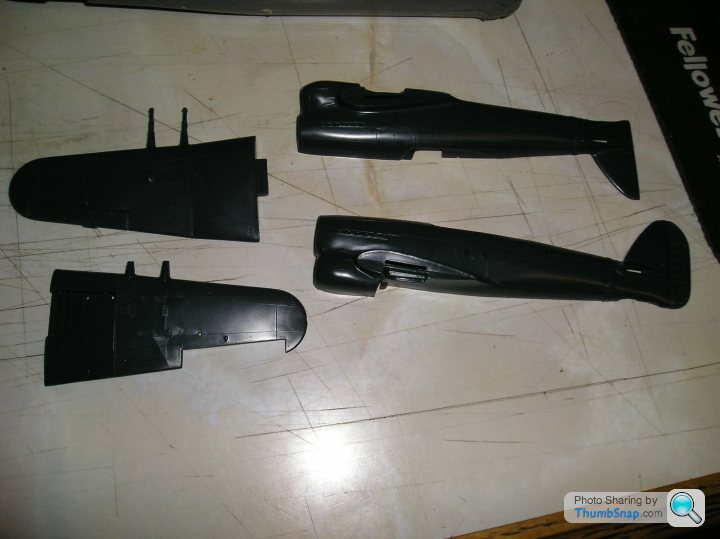
Shows the basic fuselage and wing mouldings untouched
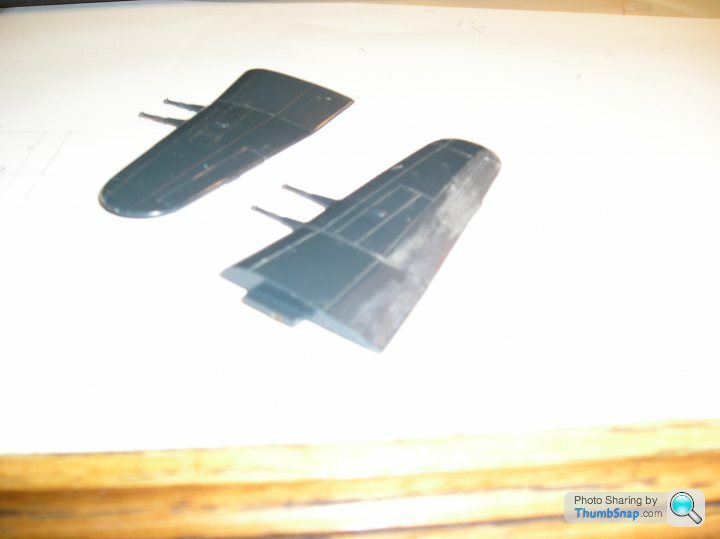
Shows the thinning out process underway
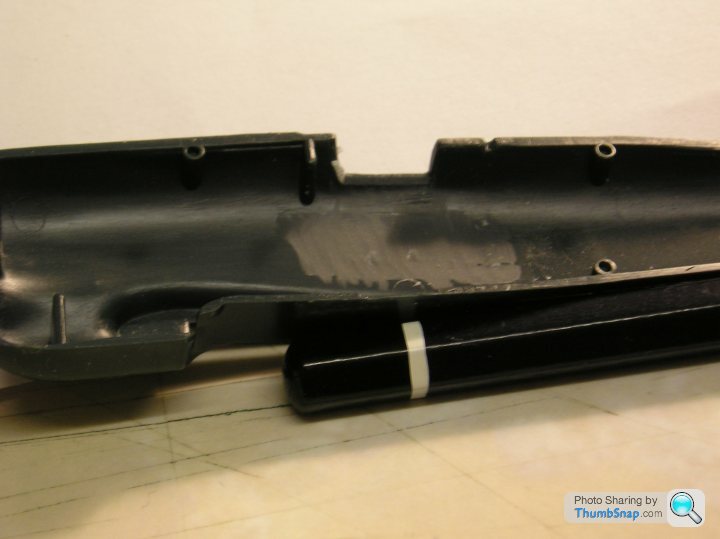
Now I have started the basic thinning out and cleaning up of the cockpit area, I will be doing some basic detailing but as I have decided that the canopy will stay closed much will not be seen and can be hinted at rather than a full detailled cockpit being needed
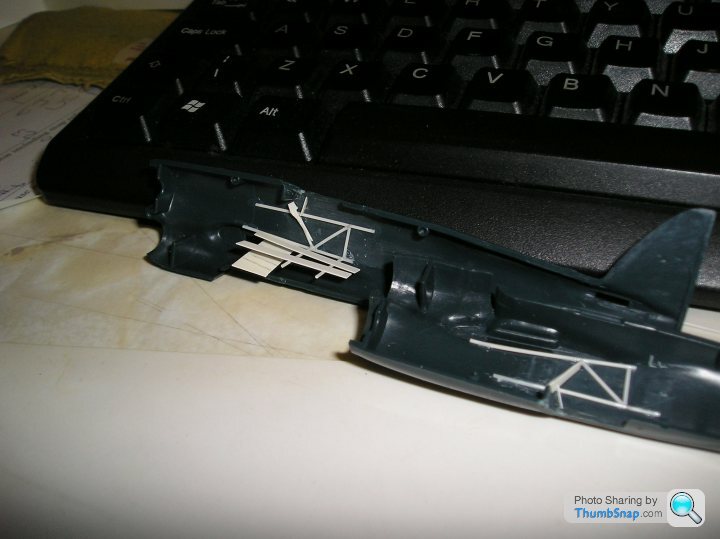
Hawker's had a strange method of building the Typhoon and Tempest series, using a tubular fore end married to a stressed skin rear end, joined just aft of the cockpit. Here I have added some of the tubular frames that can (maybe) be seen through a closed canopy and have added the pilot's footboards (no floor in these babies) and part of the instrument panel and the front edge of the opening door frame is visible too
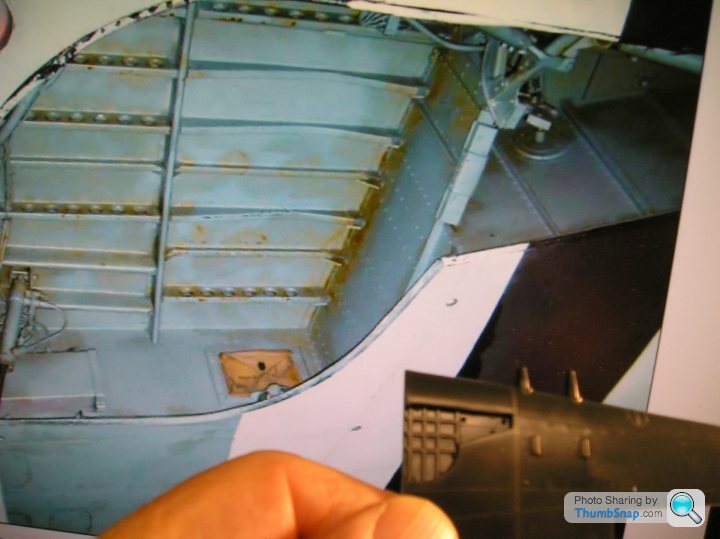
Frog made a very good attempt at wheel well interior
But it has to come out, new roof panels and framework detailing will be added as the build progresses.
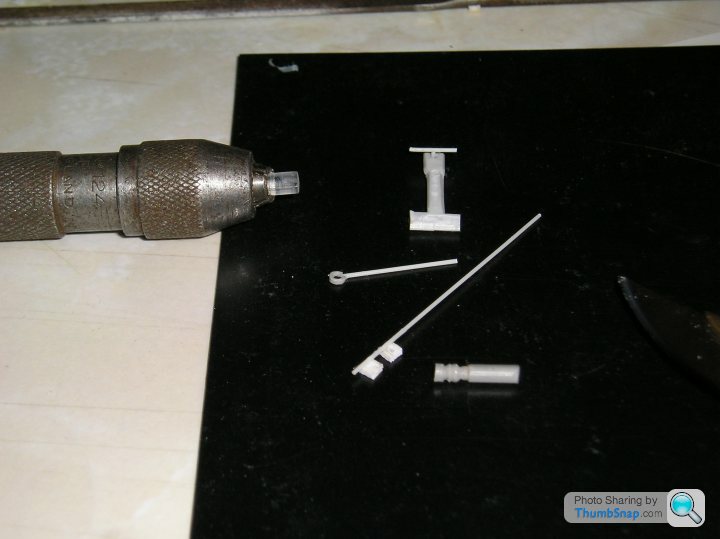
This is where I left off last night. The pieces shown here are the control support bracket (non-scale but invisible) forthe stick and rudder bar. This fits below the foot boards, painted black it wont be intrusive. Here too you can see the first version (OK there may be a couple of these made yet) of the mkll reflector sight (the funny nobbly strut thingy) the control yoke yet to be detailed with buttons and braces
of the mkll reflector sight (the funny nobbly strut thingy) the control yoke yet to be detailed with buttons and braces
There is also the rudder pedal bar and in crude condition at present, the two rudder pedals with the brake bars on top, yet to be cut off and added separately to the bar.
Also in view in my large pin vice is the first attempt at the glass cover for the magnetic compass that will live above the rudder pedals. This piece of clear styrene will probably be used as the upper portion of the reflector sight lens too.
All very tentative so far but it is giving me lots of pleasure using my modelling brain again
Here's one I did earlier
1980 IPMS Nats
The Nantucket Sleigh Ride
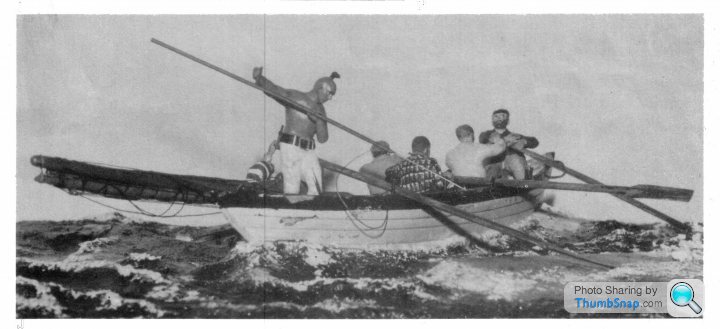
I wonder where that is now?
Bill
Watching the group build planning coming to fruition I decided to return to scale modelling after a VERY long absence.
Overcoming domestic displeasure can be very much a "manning up" process. SWWSMBO has not been the happiest bunny in the warren. "I thought you had grown up away from all that..."
Still here I is!

As I have a Frog Typhoon in my cache I chose that to start with.
Eric Mc did a very nice version of this kit a while ago, so I knew it could make up into a decent model, like most of the kits that emerged from Rovex in the sixties and seventies
Looking at the mouldings, in a blackish grey 'styrene I detected the usual generous amount of plastic around the wings. Most models of the age had a set of wings that look too bulky to me, so I usually thinned out the trailing edges to get a more aerodynamic shape to them.
First thing for me then was to start to scrape off the huge amount of excess at the T.E, starting with the starboard wing upper and lower panels

Shows the basic fuselage and wing mouldings untouched

Shows the thinning out process underway

Now I have started the basic thinning out and cleaning up of the cockpit area, I will be doing some basic detailing but as I have decided that the canopy will stay closed much will not be seen and can be hinted at rather than a full detailled cockpit being needed

Hawker's had a strange method of building the Typhoon and Tempest series, using a tubular fore end married to a stressed skin rear end, joined just aft of the cockpit. Here I have added some of the tubular frames that can (maybe) be seen through a closed canopy and have added the pilot's footboards (no floor in these babies) and part of the instrument panel and the front edge of the opening door frame is visible too

Frog made a very good attempt at wheel well interior
But it has to come out, new roof panels and framework detailing will be added as the build progresses.

This is where I left off last night. The pieces shown here are the control support bracket (non-scale but invisible) forthe stick and rudder bar. This fits below the foot boards, painted black it wont be intrusive. Here too you can see the first version (OK there may be a couple of these made yet)
 of the mkll reflector sight (the funny nobbly strut thingy) the control yoke yet to be detailed with buttons and braces
of the mkll reflector sight (the funny nobbly strut thingy) the control yoke yet to be detailed with buttons and braces There is also the rudder pedal bar and in crude condition at present, the two rudder pedals with the brake bars on top, yet to be cut off and added separately to the bar.
Also in view in my large pin vice is the first attempt at the glass cover for the magnetic compass that will live above the rudder pedals. This piece of clear styrene will probably be used as the upper portion of the reflector sight lens too.
All very tentative so far but it is giving me lots of pleasure using my modelling brain again
Here's one I did earlier
1980 IPMS Nats
The Nantucket Sleigh Ride

I wonder where that is now?
Bill
I have a minidrill (lightweight Dremel thingy) that I could thin out the sidewalls with but prefer the use of my number two blade as a scraper. With the blade I'm in control, with the machine it's a bit of a lottery, I've had melted sidewalls and even more to do, putting right in the past. 
How much thinning does the cockpit need?
Can you thin the resin parts instead of going overboard on the fuselage?

How much thinning does the cockpit need?
Can you thin the resin parts instead of going overboard on the fuselage?
perdu said:
I have a minidrill (lightweight Dremel thingy) that I could thin out the sidewalls with but prefer the use of my number two blade as a scraper. With the blade I'm in control, with the machine it's a bit of a lottery, I've had melted sidewalls and even more to do, putting right in the past. 
How much thinning does the cockpit need?
Can you thin the resin parts instead of going overboard on the fuselage?
Yeah the Dremel is no good on plastic really.
How much thinning does the cockpit need?
Can you thin the resin parts instead of going overboard on the fuselage?
No idea about the resin - not got it yet!
Well a little bit done tonight.
I used my minidrill as a cutting tool with a 0.031" dia drill and removed the incorrect wheel well details from both sides. This leaves me with a decision to make.
If I cut out the plastic that would allow the wheels to retract inside the fuselage/wing box I will need to fix the wing with new, different style location pins because the slat that goes into the fuselage slot is bang in the middle of the retracting space.
I am going to make up new inner wheel wells with the proper "looking" reinforcement ribs inside and I hope to add the inspection window you can see in the wheel well wall too. Shall I go all the way? Or will it be wasted effort?
Don't, under any circumstances ask my missus
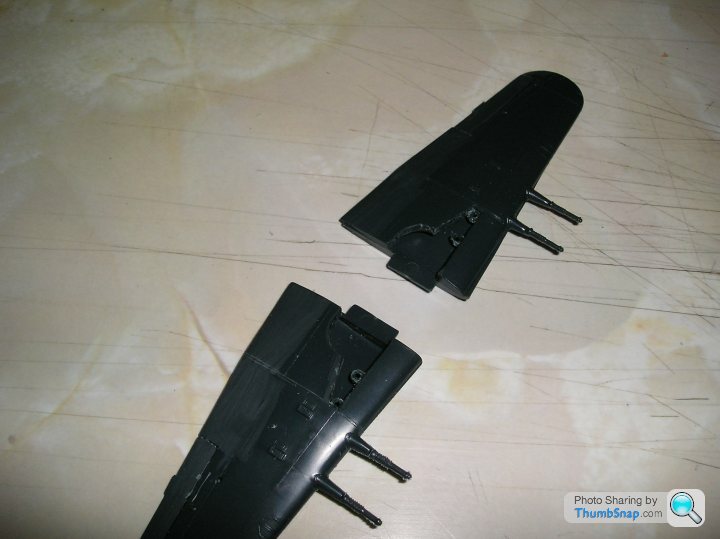
I have a large shoe box full of "things under wings", rescued bombs, rockets, weapons systems (Matchbox Phantom fuselage mounted gun fuel tank, Airfix Hunter Aden gun pack etc) that also has some wheels and other discarded bits of kits.
Guess what I found?
I haven't been able to get a decent photo, so you can play at peering through thick fog at...
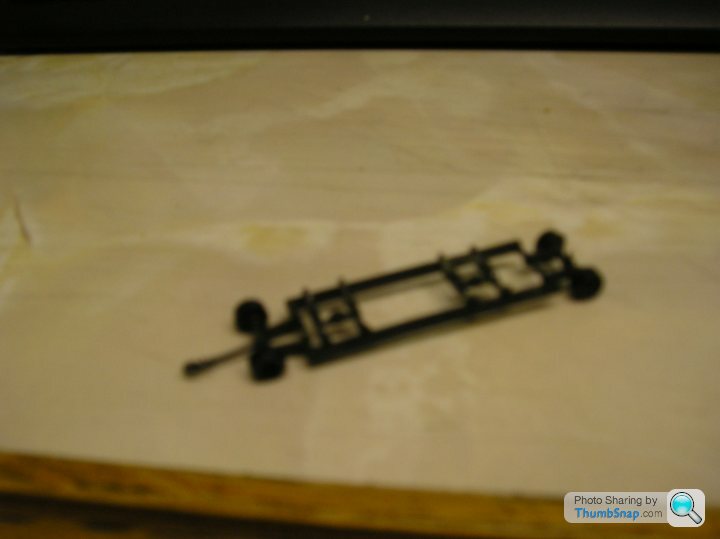
I used my minidrill as a cutting tool with a 0.031" dia drill and removed the incorrect wheel well details from both sides. This leaves me with a decision to make.
If I cut out the plastic that would allow the wheels to retract inside the fuselage/wing box I will need to fix the wing with new, different style location pins because the slat that goes into the fuselage slot is bang in the middle of the retracting space.
I am going to make up new inner wheel wells with the proper "looking" reinforcement ribs inside and I hope to add the inspection window you can see in the wheel well wall too. Shall I go all the way? Or will it be wasted effort?
Don't, under any circumstances ask my missus


I have a large shoe box full of "things under wings", rescued bombs, rockets, weapons systems (Matchbox Phantom fuselage mounted gun fuel tank, Airfix Hunter Aden gun pack etc) that also has some wheels and other discarded bits of kits.
Guess what I found?
I haven't been able to get a decent photo, so you can play at peering through thick fog at...

perdu said:
Guess what I found?
I haven't been able to get a decent photo, so you can play at peering through thick fog at...

Ha! Guess what I repaired/painted tonight?I haven't been able to get a decent photo, so you can play at peering through thick fog at...

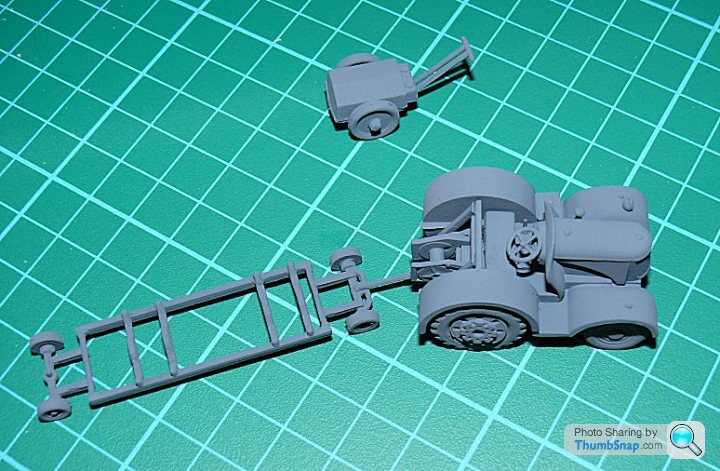
Here's a thing: I removed the plastic pieces from between the bomb cradle pairs becasue I thought they looked exactly like running sprues (which I asssumed I'd forgotten to remove when I built the old Stirling back in about 1981). I notice your has them, so I wonder if I removed a 'real' component??
I wish I still had the old David Brown from the Stirling kit, jammy beggar...
I remember when my brother built the Stirling that all of the trolleys had the same configuration. I'm sure the extra ribs were on them.
Are they visible on the picture you showed us t'other day?
I would think that with such a very small sprue and moulding the braces would probably be on the real thing too.

EDIT IN BIG WRITING
belay that!
I've just examined the actual piece of what is honestly tat and I reckon you are right.
The sprue pieces are dissimilar on mine and very unconvincing
Mine are coming off too!
I remember when my brother built the Stirling that all of the trolleys had the same configuration. I'm sure the extra ribs were on them.
Are they visible on the picture you showed us t'other day?
I would think that with such a very small sprue and moulding the braces would probably be on the real thing too.

EDIT IN BIG WRITING
belay that!
I've just examined the actual piece of what is honestly tat and I reckon you are right.
The sprue pieces are dissimilar on mine and very unconvincing
Mine are coming off too!
Edited by perdu on Tuesday 18th January 23:47
perdu said:
I wish I still had the old David Brown from the Stirling kit, jammy beggar...
I remember when my brother built the Stirling that all of the trolleys had the same configuration. I'm sure the extra ribs were on them.
Are they visible on the picture you showed us t'other day?
I would think that with such a very small sprue and moulding the braces would probably be on the real thing too.

EDIT IN BIG WRITING
belay that!
I've just examined the actual piece of what is honestly tat and I reckon you are right.
The sprue pieces are dissimilar on mine and very unconvincing
Mine are coming off too!
Every picture I can find of an assembled Airfix bomb trolley still has them on. It would be a huge bit of luck if the real thing had braces that looked exactly like sprues, so that's why mine are in the bin.I remember when my brother built the Stirling that all of the trolleys had the same configuration. I'm sure the extra ribs were on them.
Are they visible on the picture you showed us t'other day?
I would think that with such a very small sprue and moulding the braces would probably be on the real thing too.

EDIT IN BIG WRITING
belay that!
I've just examined the actual piece of what is honestly tat and I reckon you are right.
The sprue pieces are dissimilar on mine and very unconvincing
Mine are coming off too!
Edited by perdu on Tuesday 18th January 23:47
I wonder what the original Airfix instructions said??
Perdu, I'm so glad that we have persuaded you to have joined the fray (I'm too busy at this time to even begin thinking about where I shall start my kit!).
I guess that shot of the whaling boat model represented a "catch boat" from Melville's Piqoud and that the standing harpoonist depicts Queequeg the tattooed bed-mate of Ishmael from the 1959 John Huston movie- a film that I love (but the book is hard work!)
Ironically, Gregory Peck's last movie appearance was in Moby Dick, a remake with Patrick Stewart playing Ahab.
Good luck with the build- I'll be catching up once I'm settled into this new job..
I guess that shot of the whaling boat model represented a "catch boat" from Melville's Piqoud and that the standing harpoonist depicts Queequeg the tattooed bed-mate of Ishmael from the 1959 John Huston movie- a film that I love (but the book is hard work!)
Ironically, Gregory Peck's last movie appearance was in Moby Dick, a remake with Patrick Stewart playing Ahab.
Good luck with the build- I'll be catching up once I'm settled into this new job..
Bridge Plates, were fitted to all Allied Military Vehicles and seem to have had the "rounded up" weight of the machine stencilled on them (probably if in use "in theatre")
I have just Googled and found a picture of a Willy's Jeep with a number 2 stencilled on it, for two tons. None of that metric crapule in OUR war.
I think some American kit had square yellow bridge plates rather than round...
The yellow metal plates were intended as far as I can remember to act as weight markers so that MPs and engineers operating any bridge or ferry could decide whether they should allow the piece of kit to use the Bridge, since all bridging equipment had its own limits built in for safety
Post war most military vehicles were not number marked since all bridges by then were up to the same standards (allegedly) and all the yellow plates were un-numbered when I had a rifle.
I'm still worried about the blue you have on these pieces of kit, needs to be far darker to me near enough to roundel blue I'd think and as Eric rightly says much of the airfield kit was painted in Dark Green or Green/Brown camo
I think the trailers would be Blue though
Opened up a new minefield haven't you?
I think the n/s roundel is the thing too and white number/lettering is right.

Kenny, yes basically I did get the idea from Melville (Me? I love the book and have read it several times... I think I hear another go soon, a'calling me)
Not being sure how to mark his tattooos I just left the Heathen as "a South Sea Islander", in '79 there wasn't such a rich information resource available as the internet is these days.
I researched through several branches of Brum's Libraries though and managed to find suitable info for the catcher boat and her crew.
I had wanted to try my hand at a clinker built boat from plasticard for a while and the idea to make Nantucket Sleighride came from this.
I finished the boat in time for the IPMS nats in '80 and was lucky to win class Q and a separate Ships Trophy with it
That was when I was a competitive animal
I think he's dead now, 'cos now it's for fun alone

I have just Googled and found a picture of a Willy's Jeep with a number 2 stencilled on it, for two tons. None of that metric crapule in OUR war.
I think some American kit had square yellow bridge plates rather than round...
The yellow metal plates were intended as far as I can remember to act as weight markers so that MPs and engineers operating any bridge or ferry could decide whether they should allow the piece of kit to use the Bridge, since all bridging equipment had its own limits built in for safety
Post war most military vehicles were not number marked since all bridges by then were up to the same standards (allegedly) and all the yellow plates were un-numbered when I had a rifle.
I'm still worried about the blue you have on these pieces of kit, needs to be far darker to me near enough to roundel blue I'd think and as Eric rightly says much of the airfield kit was painted in Dark Green or Green/Brown camo
I think the trailers would be Blue though
Opened up a new minefield haven't you?

I think the n/s roundel is the thing too and white number/lettering is right.

Kenny, yes basically I did get the idea from Melville (Me? I love the book and have read it several times... I think I hear another go soon, a'calling me)
Not being sure how to mark his tattooos I just left the Heathen as "a South Sea Islander", in '79 there wasn't such a rich information resource available as the internet is these days.
I researched through several branches of Brum's Libraries though and managed to find suitable info for the catcher boat and her crew.
I had wanted to try my hand at a clinker built boat from plasticard for a while and the idea to make Nantucket Sleighride came from this.
I finished the boat in time for the IPMS nats in '80 and was lucky to win class Q and a separate Ships Trophy with it
That was when I was a competitive animal
I think he's dead now, 'cos now it's for fun alone

perdu said:
Bridge Plates, were fitted to all Allied Military Vehicles and seem to have had the "rounded up" weight of the machine stencilled on them (probably if in use "in theatre")
I have just Googled and found a picture of a Willy's Jeep with a number 2 stencilled on it, for two tons. None of that metric crapule in OUR war.
I think some American kit had square yellow bridge plates rather than round...
The yellow metal plates were intended as far as I can remember to act as weight markers so that MPs and engineers operating any bridge or ferry could decide whether they should allow the piece of kit to use the Bridge, since all bridging equipment had its own limits built in for safety
Post war most military vehicles were not number marked since all bridges by then were up to the same standards (allegedly) and all the yellow plates were un-numbered when I had a rifle.
I'm still worried about the blue you have on these pieces of kit, needs to be far darker to me near enough to roundel blue I'd think and as Eric rightly says much of the airfield kit was painted in Dark Green or Green/Brown camo
I think the trailers would be Blue though
Opened up a new minefield haven't you?
I think the n/s roundel is the thing too and white number/lettering is right.

Many thanks Perdu - very informatave. I have just Googled and found a picture of a Willy's Jeep with a number 2 stencilled on it, for two tons. None of that metric crapule in OUR war.
I think some American kit had square yellow bridge plates rather than round...
The yellow metal plates were intended as far as I can remember to act as weight markers so that MPs and engineers operating any bridge or ferry could decide whether they should allow the piece of kit to use the Bridge, since all bridging equipment had its own limits built in for safety
Post war most military vehicles were not number marked since all bridges by then were up to the same standards (allegedly) and all the yellow plates were un-numbered when I had a rifle.
I'm still worried about the blue you have on these pieces of kit, needs to be far darker to me near enough to roundel blue I'd think and as Eric rightly says much of the airfield kit was painted in Dark Green or Green/Brown camo
I think the trailers would be Blue though
Opened up a new minefield haven't you?

I think the n/s roundel is the thing too and white number/lettering is right.

No problem, I'll respray the tractor. I still fancy the blue, so if you happen to find the correct Humbrol or Revell number, I'll sort it. In fact, I want to add a rear view mirror on a stalk, so another coat wouldn't go amiss anyway.
Too late for the railway crane, but it doesn't really matter since it's not really an RAF crane at all is it - just a crane on a dockside that happened to be painted in the late RAF blue, slightly darkened with age.
How's that for a compromise?

dr_gn said:
perdu said:
Bridge Plates, were fitted to all Allied Military Vehicles and seem to have had the "rounded up" weight of the machine stencilled on them (probably if in use "in theatre")
I have just Googled and found a picture of a Willy's Jeep with a number 2 stencilled on it, for two tons. None of that metric crapule in OUR war.
I think some American kit had square yellow bridge plates rather than round...
The yellow metal plates were intended as far as I can remember to act as weight markers so that MPs and engineers operating any bridge or ferry could decide whether they should allow the piece of kit to use the Bridge, since all bridging equipment had its own limits built in for safety
Post war most military vehicles were not number marked since all bridges by then were up to the same standards (allegedly) and all the yellow plates were un-numbered when I had a rifle.
I'm still worried about the blue you have on these pieces of kit, needs to be far darker to me near enough to roundel blue I'd think and as Eric rightly says much of the airfield kit was painted in Dark Green or Green/Brown camo
I think the trailers would be Blue though
Opened up a new minefield haven't you?
I think the n/s roundel is the thing too and white number/lettering is right.

Many thanks Perdu - very informatave. I have just Googled and found a picture of a Willy's Jeep with a number 2 stencilled on it, for two tons. None of that metric crapule in OUR war.
I think some American kit had square yellow bridge plates rather than round...
The yellow metal plates were intended as far as I can remember to act as weight markers so that MPs and engineers operating any bridge or ferry could decide whether they should allow the piece of kit to use the Bridge, since all bridging equipment had its own limits built in for safety
Post war most military vehicles were not number marked since all bridges by then were up to the same standards (allegedly) and all the yellow plates were un-numbered when I had a rifle.
I'm still worried about the blue you have on these pieces of kit, needs to be far darker to me near enough to roundel blue I'd think and as Eric rightly says much of the airfield kit was painted in Dark Green or Green/Brown camo
I think the trailers would be Blue though
Opened up a new minefield haven't you?

I think the n/s roundel is the thing too and white number/lettering is right.

No problem, I'll respray the tractor. I still fancy the blue, so if you happen to find the correct Humbrol or Revell number, I'll sort it. In fact, I want to add a rear view mirror on a stalk, so another coat wouldn't go amiss anyway.
Too late for the railway crane, but it doesn't really matter since it's not really an RAF crane at all is it - just a crane on a dockside that happened to be painted in the late RAF blue, slightly darkened with age.
How's that for a compromise?


I still think a kind of Roundel Blue with heavily weathered "out in all weathers matt" kind of way would be nearest
When I was shopping today I couldnt see a specific colour anywhere that is quite like it
Just looked up BS381c in an online colour chart
This one works nicely on my monitor, very close to my conceptions of true colours, rare enough on t'internet I find. Might be worth a bookmarking!
http://www.stephen.hull.btinternet.co.uk/bs381c.ht...
BS381 105 Oxford Blue looks nearest on my monitor but there is also BS381 108 Aircraft Blue and BS381 110 Roundel Blue to use as indicators of paintwork on windblasted airfields
If you chose an Oxford Blue as the tractor colour the RAF markings would have sufficient contrast to show up against it
Oh yes, BS381c is the standard paint spec for post war HMG equipment ISTR and can be cross ref-fed against other NATO kit too
perdu said:
dr_gn said:
perdu said:
Bridge Plates, were fitted to all Allied Military Vehicles and seem to have had the "rounded up" weight of the machine stencilled on them (probably if in use "in theatre")
I have just Googled and found a picture of a Willy's Jeep with a number 2 stencilled on it, for two tons. None of that metric crapule in OUR war.
I think some American kit had square yellow bridge plates rather than round...
The yellow metal plates were intended as far as I can remember to act as weight markers so that MPs and engineers operating any bridge or ferry could decide whether they should allow the piece of kit to use the Bridge, since all bridging equipment had its own limits built in for safety
Post war most military vehicles were not number marked since all bridges by then were up to the same standards (allegedly) and all the yellow plates were un-numbered when I had a rifle.
I'm still worried about the blue you have on these pieces of kit, needs to be far darker to me near enough to roundel blue I'd think and as Eric rightly says much of the airfield kit was painted in Dark Green or Green/Brown camo
I think the trailers would be Blue though
Opened up a new minefield haven't you?
I think the n/s roundel is the thing too and white number/lettering is right.

Many thanks Perdu - very informatave. I have just Googled and found a picture of a Willy's Jeep with a number 2 stencilled on it, for two tons. None of that metric crapule in OUR war.
I think some American kit had square yellow bridge plates rather than round...
The yellow metal plates were intended as far as I can remember to act as weight markers so that MPs and engineers operating any bridge or ferry could decide whether they should allow the piece of kit to use the Bridge, since all bridging equipment had its own limits built in for safety
Post war most military vehicles were not number marked since all bridges by then were up to the same standards (allegedly) and all the yellow plates were un-numbered when I had a rifle.
I'm still worried about the blue you have on these pieces of kit, needs to be far darker to me near enough to roundel blue I'd think and as Eric rightly says much of the airfield kit was painted in Dark Green or Green/Brown camo
I think the trailers would be Blue though
Opened up a new minefield haven't you?

I think the n/s roundel is the thing too and white number/lettering is right.

No problem, I'll respray the tractor. I still fancy the blue, so if you happen to find the correct Humbrol or Revell number, I'll sort it. In fact, I want to add a rear view mirror on a stalk, so another coat wouldn't go amiss anyway.
Too late for the railway crane, but it doesn't really matter since it's not really an RAF crane at all is it - just a crane on a dockside that happened to be painted in the late RAF blue, slightly darkened with age.
How's that for a compromise?


I still think a kind of Roundel Blue with heavily weathered "out in all weathers matt" kind of way would be nearest
When I was shopping today I couldnt see a specific colour anywhere that is quite like it
Just looked up BS381c in an online colour chart
This one works nicely on my monitor, very close to my conceptions of true colours, rare enough on t'internet I find. Might be worth a bookmarking!
http://www.stephen.hull.btinternet.co.uk/bs381c.ht...
BS381 105 Oxford Blue looks nearest on my monitor but there is also BS381 108 Aircraft Blue and BS381 110 Roundel Blue to use as indicators of paintwork on windblasted airfields
If you chose an Oxford Blue as the tractor colour the RAF markings would have sufficient contrast to show up against it
Oh yes, BS381c is the standard paint spec for post war HMG equipment ISTR and can be cross ref-fed against other NATO kit too
Talking of colours, do you happen to know the correct colour for the inside of the wing / flaps? According to the instructions, the wheel wells should be silver, so maybe it's that?
I'd rather paint the wells and wing internals cockpit green, but I can't find a reference for the wing internals of an aircraft with silver wheel wells.
Cheers!
ETA what do you recon to this colour (on the Tamiya Mosquito Set):
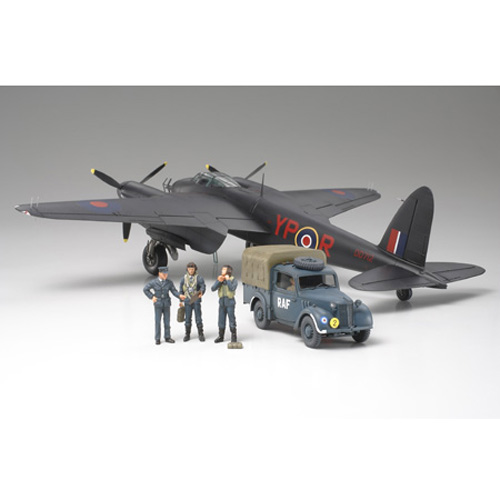
I think its Tamiya X-03 Royal Blue. Doesn't look that different to my crane to my eyes at least.
Edited by dr_gn on Thursday 20th January 09:20
Hmm looks a bit like my imagined image
I don't think it ought to be that same colour as the uniforms though do you? A leetle darker and not even slightly glossy for wartime finish. Even in peacetime airfield equipment gets wind lashed to a dull finish.
I did a tad more last night trying out a Revell sludge coloured grey green for the interior, but I'm not convinced
What d'you think guys?
I noticed on the photo I posted on your thread dr_gn that the fuselage frames in the cockpit are silver alloy tubing so they can be left in relief against the painted cockpit walls
So last night I picked out those frames and started putting together the joystick and rudder pedals onto the carrying block
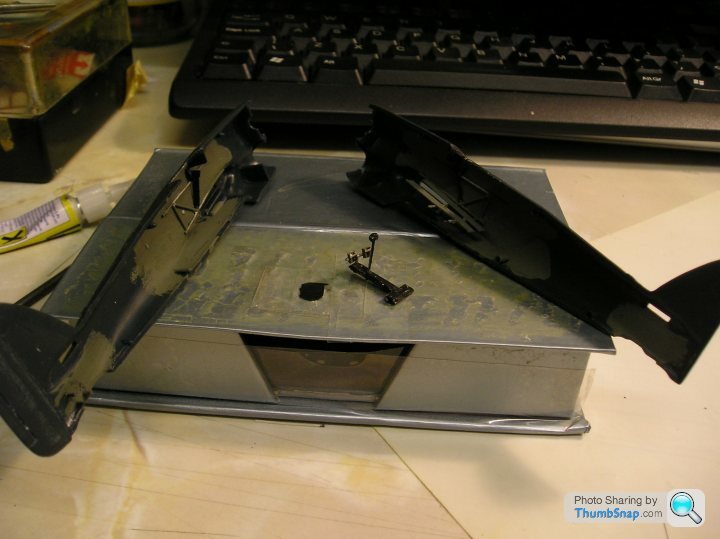
That black square on the boxlid will become the standard blind flying panel when its finished
mind you, with all the squinting I'm having to do it is a dead cert that I cannot build to competition standards any more
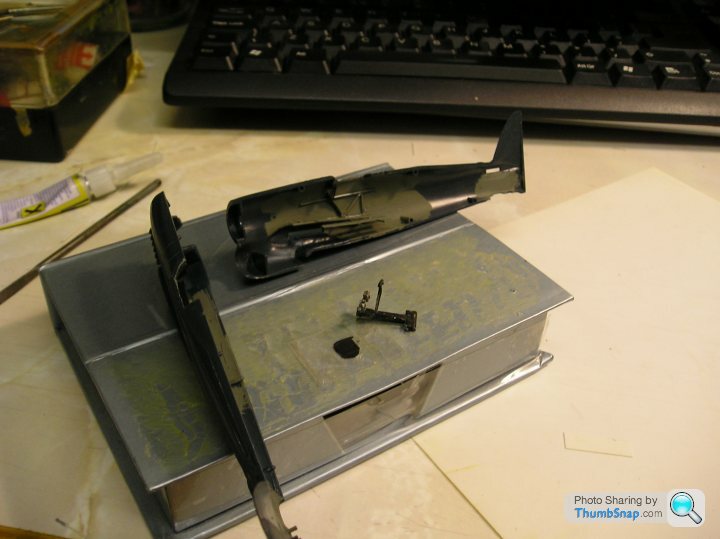
I don't think it ought to be that same colour as the uniforms though do you? A leetle darker and not even slightly glossy for wartime finish. Even in peacetime airfield equipment gets wind lashed to a dull finish.
I did a tad more last night trying out a Revell sludge coloured grey green for the interior, but I'm not convinced
What d'you think guys?
I noticed on the photo I posted on your thread dr_gn that the fuselage frames in the cockpit are silver alloy tubing so they can be left in relief against the painted cockpit walls
So last night I picked out those frames and started putting together the joystick and rudder pedals onto the carrying block

That black square on the boxlid will become the standard blind flying panel when its finished
mind you, with all the squinting I'm having to do it is a dead cert that I cannot build to competition standards any more


Yes I agree, Frog moulds but not necessarily Frog packs.
There is so much emphasis on Airfix nostalgia that Frog gets overlooked, unfairly IMO. I know their kits were sometimes a bit iffy but they could also be very good, and because of their odd distribution set-up you could get them at the post office and local places like that.
There is so much emphasis on Airfix nostalgia that Frog gets overlooked, unfairly IMO. I know their kits were sometimes a bit iffy but they could also be very good, and because of their odd distribution set-up you could get them at the post office and local places like that.
Gassing Station | Scale Models | Top of Page | What's New | My Stuff



